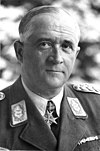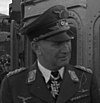
The Luftwaffe was the aerial-warfare branch of the Wehrmacht before and during World War II. Germany's military air arms during World War I, the Luftstreitkräfte of the Imperial Army and the Marine-Fliegerabteilung of the Imperial Navy, had been disbanded in May 1920 in accordance with the terms of the 1919 Treaty of Versailles which banned Germany from having any air force.
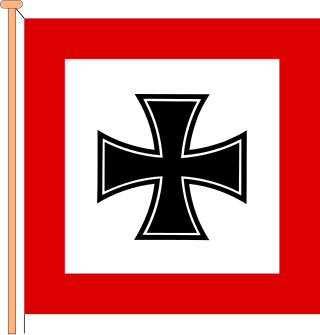
The Oberkommando des Heeres was the high command of the Army of Nazi Germany. It was founded in 1935 as part of Adolf Hitler's rearmament of Germany. OKH was de facto the most important unit within the German war planning until the defeat at Moscow in December 1941.
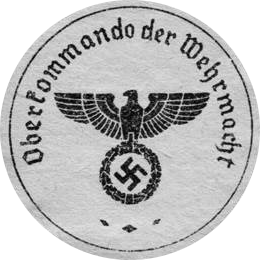
The Oberkommando der Wehrmacht was the supreme military command and control office of Nazi Germany during World War II. Created in 1938, the OKW replaced the Reich Ministry of War and had oversight over the individual high commands of the country's armed forces: the army, navy, and air force.

The Bundeswehr is the armed forces of the Federal Republic of Germany. The Bundeswehr is divided into a military part and a civil part, the military part consisting of the German Army, the German Navy, the German Air Force, the Joint Support Service, the Joint Medical Service, and the Cyber and Information Domain Service.
Generalfeldmarschall was a rank in the armies of several German states and the Holy Roman Empire (Reichsgeneralfeldmarschall); in the Habsburg monarchy, the Austrian Empire and Austria-Hungary, the rank Feldmarschall was used. The rank was the equivalent to Großadmiral in the Kaiserliche Marine and Kriegsmarine, a five-star rank, comparable to OF-10 in today's NATO naval forces.
This is a list of words, terms, concepts, and slogans that have been or are used by the German military. Ranks and translations of nicknames for vehicles are included. Also included are some general terms from the German language found frequently in military jargon. Some terms are from the general German cultural background, others are given to show a change that was made before or after the Nazi era. Some factories that were the primary producers of military equipment, especially tanks, are also given.

The German Air Force is the aerial warfare branch of the Bundeswehr, the armed forces of Germany. The German Air Force was founded in 1956 during the era of the Cold War as the aerial warfare branch of the armed forces of West Germany. After the reunification of West and East Germany in 1990, it integrated parts of the air force of the former German Democratic Republic, which itself had been founded in 1956 as part of the National People's Army. There is no organizational continuity between the current German Air Force and the former Luftwaffe of the Wehrmacht founded in 1935, which was completely disbanded in 1945/46 after World War II. The term Luftwaffe that is used for both the historic and the current German air force is the German-language generic designation of any air force.

A Generaloberst was the second-highest general officer rank in the German Reichswehr and Wehrmacht, the Austro-Hungarian Common Army, the East German National People's Army and in their respective police services. The rank was equal to a four-star full general but below a general field marshal. The rank was equivalent to a Generaladmiral in the Kriegsmarine until 1945 or to a Flottenadmiral in the Volksmarine until 1990. It was the highest ordinary military rank and the highest military rank awarded in peacetime; the higher rank of general field marshal was awarded only in wartime by the head of state. In general, a Generaloberst had the same privileges as a general field marshal.

The Federal Ministry of Defence, abbreviated BMVg, is a top-level federal agency, headed by the Federal Minister of Defence as a member of the Cabinet of Germany. The ministry is headquartered at the Hardthöhe district in Bonn and has a second office in the Bendlerblock building in Berlin, which is occasionally used as a metonym to denote the entire Ministry.

The Oberkommando der Luftwaffe was the high command of the air force of Nazi Germany.
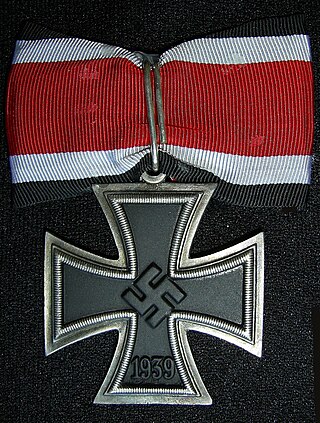
The Knight's Cross of the Iron Cross, or simply the Knight's Cross , and its variants, were the highest awards in the military and paramilitary forces of Nazi Germany during World War II. Although technically lower in precedence than the Grand Cross of the Iron Cross, the Grand Cross was never awarded at-large to Nazi German military and paramilitary forces, with its only award being made to Reichsmarschall Hermann Göring in September 1939.
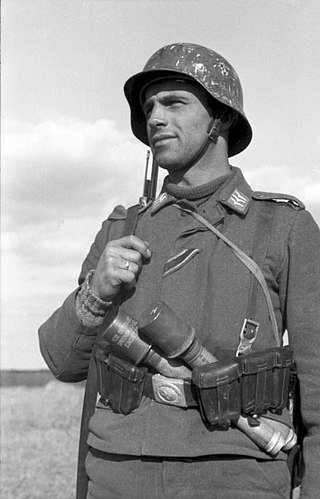
The Luftwaffe Field Divisions were the ground forces of the German Luftwaffe during World War II.

Hans-Jürgen Stumpff, was a German general during World War II and was one of the signatories to Germany's unconditional surrender at the end of the war.

The Wehrmacht were the unified armed forces of Nazi Germany from 1935 to 1945. It consisted of the Heer (army), the Kriegsmarine (navy) and the Luftwaffe. The designation "Wehrmacht" replaced the previously used term Reichswehr and was the manifestation of the Nazi regime's efforts to rearm Germany to a greater extent than the Treaty of Versailles permitted.
Viktor von Schwedler was a general in the Wehrmacht of Nazi Germany who commanded an army corps and a military district during World War II. He was awarded the Knight's Cross of the Iron Cross.

The Inspector of the Air Force is the commander of the Air Force of the modern-day German Armed Forces, the Bundeswehr. The Inspector is responsible for the readiness of personnel and materiel in the German Air Force, in that function reports directly to the Federal Minister of Defence. The current Inspector is Ingo Gerhartz, appointed on 29 May 2018.

The Wehrmachtbefehlshaber was the German chief military position, in countries occupied by the Wehrmacht which were headed by a civilian administration. The main objective was military security in the area, and command the defense in case of attack or invasion. The Wehrmachtbefehlshaber also had a judicial function, as he served as judge in German military courts. He had no control over Army units, but was responsible for defence, and housing for troops. In the occupied territories of the Soviet Union, the Wehrmachtsbefehlshaber was also responsible for securing the occupied territories, protect transport links and recording the crops.

Chief of the Kriegsmarine Personnel Office was a leading position within the German Kriegsmarine High Command in Nazi Germany.



